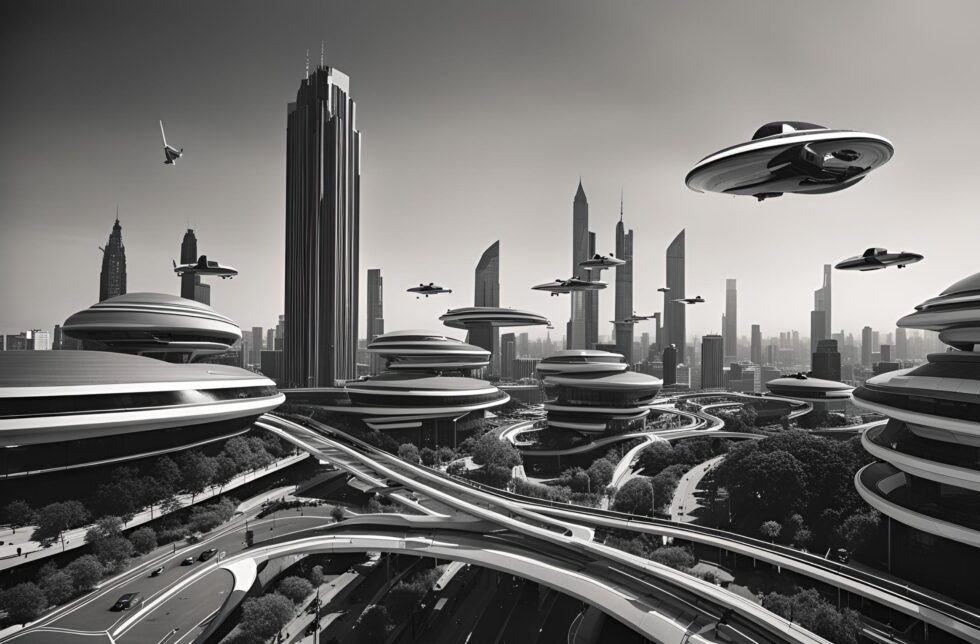
In the year 2045, the sky was no longer the exclusive domain of birds, planes, and the occasional drone. The horizon was now filled with sleek, aerodynamic vehicles gliding effortlessly through the air. Flying cars had become mainstream, transforming the very fabric of human civilization.
The revolution began with the invention of the Quantum Lift Engine, a groundbreaking piece of technology that harnessed quantum fluctuations to generate lift and propulsion. This engine, small enough to fit in the palm of your hand, powered the first generation of flying cars. Initially, the wealthy and the adventurous were the early adopters. However, within a decade, mass production and government subsidies made flying cars accessible to the average citizen.
Cities adapted quickly to this new mode of transportation. Skyscrapers were retrofitted with vertical parking lots, and the skyline was dotted with floating traffic signals and skyways. Ground-level streets, once clogged with honking horns and bumper-to-bumper traffic, became serene pathways for pedestrians and cyclists. The air was cleaner, and noise pollution was significantly reduced. Urban planners reveled in the newfound space, converting former highways into green belts and community parks.

The impact on society was profound. Commutes that once took hours were now reduced to mere minutes. People could live farther from their workplaces without the dread of long, stressful drives. This led to the decentralization of cities, with smaller towns and rural areas experiencing a renaissance. Families moved out of cramped apartments and into spacious homes surrounded by nature, all while maintaining their urban jobs.
However, the transition was not without its challenges. The skies, once open and free, became congested with traffic. Air traffic control systems, initially designed for commercial airplanes, struggled to manage the sheer volume of flying cars. The government had to step in, implementing strict regulations and developing advanced AI-driven traffic management systems. These systems, capable of processing vast amounts of data in real-time, ensured that the skies remained safe and orderly.
The rise of flying cars also brought about a new wave of innovation. Industries that had been stagnant for decades were suddenly revitalized. The automotive industry, for instance, saw a surge in demand for skilled engineers and designers. Universities introduced new courses on aerodynamics and quantum mechanics, preparing the next generation for a world where the sky was no longer the limit.
Perhaps the most significant change was in the human psyche. The ability to soar above the ground, to see the world from a bird’s-eye view, instilled a sense of freedom and possibility. People began to dream bigger and think beyond the confines of their daily lives. This shift in perspective led to a cultural renaissance, with art, literature, and music reflecting the newfound sense of liberation.
Yet, as with all technological advancements, there were unforeseen consequences. The convenience of flying cars led to a decline in physical activity. People no longer walked or cycled as much, resulting in an increase in health issues related to a sedentary lifestyle. To combat this, governments launched public health campaigns, encouraging citizens to balance the convenience of flying cars with regular exercise.
Moreover, the environmental impact of mass-produced flying cars could not be ignored. While the Quantum Lift Engine was more efficient than traditional combustion engines, the sheer number of vehicles in the sky contributed to increased energy consumption. Scientists raced to develop more sustainable energy sources, and soon, solar-powered flying cars became the norm.
In rural areas, the introduction of flying cars had a unique impact. Farmers used them to monitor crops and livestock from above, making agriculture more efficient. Remote communities, once isolated due to difficult terrain, were now easily accessible. This connectivity brought about economic growth and improved the quality of life for many.
As the years went by, flying cars became an integral part of human life. They were no longer a novelty but a necessity. The world had adapted, and in many ways, thrived. The sky, once a vast and empty expanse, was now a bustling thoroughfare, a testament to human ingenuity and the relentless pursuit of progress.
In the end, the mainstream adoption of flying cars was more than just a technological milestone. It was a catalyst for change, reshaping society in ways both expected and unforeseen. It brought humanity closer together, bridging distances and breaking down barriers. And as people looked up at the sky, filled with the hum of flying cars, they were reminded of the boundless possibilities that lay ahead.




